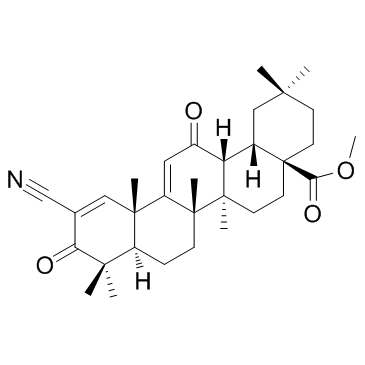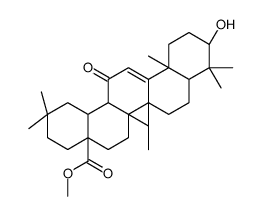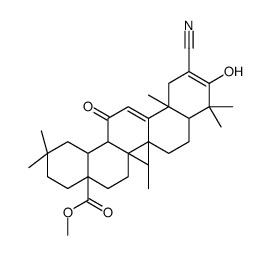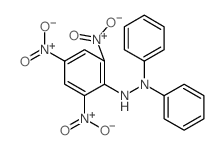218600-44-3
| Name | (4aS,6aR,6bS,8aR,12aS,14aR,14bS)-11-cyano-2,2,6a,6b,9,9,12a-heptamethyl-10,14-dioxo-1,3,4,5,6,7,8,8a,14a,14b-decahydropicene-4a-carboxylic acid |
|---|---|
| Synonyms |
2-Cyano-3,12-dioxooleana-1,9-dien-28-oic acid
RTA 401 CDDO Oleana-1,9(11)-dien-28-oic acid, 2-cyano-3,12-dioxo- RTA-401 2-cyano-3,12-dioxoolean-1,9(11)-dien-28-oic acid 2-Cyano-3,12-dioxooleana-1,9(11)-dien-28-oic acid Bardoxolone 2-cyano-9,12-dioxooleana-1,9(11)-diene-28-oic acid |
| Description | Bardoxolone is a novel nuclear regulator factor (Nrf-2) activator. |
|---|---|
| Related Catalog | |
| Target |
Nrf-2[1] |
| In Vitro | Bardoxolone methyl, a novel synthetic triterpenoid and antioxidant inflammation modulator, potently induces Nrf2 and inhibits NF-κB and Janus-activated kinase/STAT signaling. Bardoxolone methyl has been shown to induce differentiation, inhibit proliferation, and induce apoptosis in cancer cell lines[2]. |
| In Vivo | Kidney sections from Bardoxolone methyl-treated monkeys demonstrates decreased megalin protein expression despite similar mRNA expression across groups. The visualized decrease in megalin protein expression is confirmed by densitometry analyses, which demonstrated that Bardoxolone methyl administration significantly decreased megalin protein expression in the monkey kidney. Bardoxolone methyl administration does not affect the protein expression of cubilin in the kidney or the mRNA expression of cubilin in the kidney. The creatinine clearance in monkeys administered Bardoxolone methyl significantly differed from that at baseline and in vehicle-treated animals on day 28. After 28 days of Bardoxolone methyl administration, urinary albumin-to-creatinine ratios (UACRs), determined from the 24-hour urine collections, are significantly increased compared with those in animals receiving vehicle. Of note, UACRs decreases 53.3% in vehicle-treated animals and increased 27.9% in Bardoxolone methyl-treated monkeys[3]. Male C57BL/6J mice are administered oral BARD during HFD feeding (HFD/BARD), only fed a high-fat diet (HFD), or fed low-fat diet (LFD) for 21 weeks. Compared with LFD mice, HFD mice have a marked increase in the number of F4/80 crown-like structures (+95%; p<0.001), which is effectively prevented by BARD (−50%; p<0.01). Similarly, the number of F4/80 interstitial macrophages is significantly higher in HFD mice by 98% (p<0.001) compared with LFD mice and by 32% (p<0.01) compared with HFD/BARD mice[4]. |
| Animal Admin | Monkeys[3] Two separate studies are conducted in cynomolgus Monkeys. In one, cynomolgus Monkeys (n=9 per sex/dose group) are orally administered Bardoxolone methyl at 5, 30, and 300 mg/kg once daily for 12 months, with an interim analysis at 6 months and a postdose recovery analysis 4 weeks after the final dose, in a GLP environment. In a second study, female cynomolgus Monkeys (n=6 for vehicle and n=12 for treatment) are administered Bardoxolone methyl (30 mg/kg per day), as above, once daily for 28 days. Mice[4] Male C57BL/6J mice are used. After 1 week of acclimatisation to the institutional animal facility (temperature 22°C, 12 h light/dark cycle), the animals are divided into three groups (n=7): (1) mice fed a normal diet (LFD group); (2) mice fed a high-fat diet (HFD group) (40% fat); and (3) mice fed the same HFD and supplemented with BARD in drinking water (10 mg/kg body weight) (HFD/BARD group). The dose and oral administration of BARD are chosen. After 21 weeks, all mice are euthanized using CO2 asphyxiation. Part of the mesenteric fat mass in each animal is collected and stored at −80°C for Western blot analysis. Another portion of the mesenteric fat depot is fixed in 4% paraformaldehyde and embedded in paraffin for the determination of morphology and immunohistochemistry. |
| References |
| Density | 1.2±0.1 g/cm3 |
|---|---|
| Boiling Point | 632.9±55.0 °C at 760 mmHg |
| Molecular Formula | C31H41NO4 |
| Molecular Weight | 491.661 |
| Flash Point | 336.6±31.5 °C |
| Exact Mass | 491.303558 |
| PSA | 95.23000 |
| LogP | 5.76 |
| Vapour Pressure | 0.0±4.0 mmHg at 25°C |
| Index of Refraction | 1.575 |
| Storage condition | -20°C |
| Hazard Codes | Xi |
|---|
| Precursor 7 | |
|---|---|
| DownStream 1 | |







![Methyl 12-oxoisoxazolo[4,5-b]olean-9(11)-en-28-oate structure](https://image.chemsrc.com/caspic/207/218600-52-3.png)


